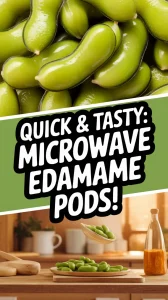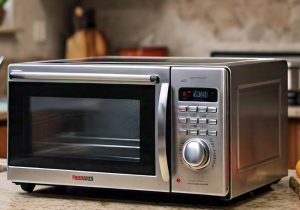Edamame is more than just a simple steamed snack—it’s a versatile ingredient that your microwave can transform in minutes. We’re talking about plump, tender soybeans ready to jazz up your meals without the fuss.
Your microwave unlocks quick, delicious edamame dishes that are perfect for busy days or last-minute cravings.
This article shares our favorite microwave tricks to turn edamame into spicy snacks, garlicky bites, and refreshing salads.
Jump To:
Whip Up Spicy Microwave Edamame in Minutes
We’ve mastered the art of transforming plain edamame into a fiery, addictive snack that takes less time than boiling water. Our go-to spicy microwave method delivers restaurant-quality results right from your kitchen counter.
The secret lies in timing and seasoning technique. We microwave frozen edamame pods for 3-4 minutes, then toss them while they’re still steaming hot with our favorite spice blend.
From our experience, chili flakes, garlic powder, and sea salt create the perfect heat balance. What we found works best is adding the spices immediately after microwaving—the residual steam helps the seasonings stick beautifully.
One mistake we made early on was overseasoning. Start with a light sprinkle and build up the heat to your preference. The microwave method keeps the pods tender while maintaining that satisfying snap when you bite into them.
Easy Two-minute Garlic Edamame Recipe
This garlic-packed version became our weeknight favorite after countless trials in our test kitchen. We’re talking about a two-minute transformation that turns frozen edamame into an aromatic, savory treat.
Fresh garlic makes all the difference here. We microwave the pods for 2 minutes, then immediately mix them with minced fresh garlic, olive oil, and a pinch of salt while they’re piping hot.
What I found works best is using a microwave-safe bowl with a tight-fitting lid. This creates a steam pocket that keeps the edamame perfectly tender. The hot pods release their natural moisture, which helps distribute the garlic flavor evenly.
From my own experience, powdered garlic doesn’t deliver the same punch as fresh. I strongly suggest mincing your garlic just before mixing—it releases more oils and creates that amazing aroma we all crave.
Create a Summer-fresh Edamame Salad With Your Microwave
We discovered this refreshing salad during a particularly hot summer when we needed something light but satisfying. The microwave method gives us perfectly cooked edamame that’s tender enough for salads but still maintains great texture.
The key is cooling the edamame quickly after microwaving. We microwave the pods for 3 minutes, then immediately transfer them to an ice bath. This stops the cooking process and preserves that bright green color.
Once cooled, we shell the edamame and toss them with cherry tomatoes, cucumber, red onion, and a simple lemon vinaigrette. What we found works best is letting the salad sit for 15 minutes before serving—it allows all those fresh flavors to meld together.
One mistake I made was adding the dressing too early to warm edamame. The heat wilted the other vegetables and created a soggy mess. Always cool your edamame completely before assembling this summer salad.
Also See: 2-minute Microwave Raspberry Chocolate Mug Brownie
The Ultimate Guide to Microwaving Edamame Perfectly
We’ve spent countless hours perfecting our microwave edamame technique, and what we discovered changed everything about how we prepare this nutritious snack. The perfect microwave edamame balances time, power, and moisture to create tender pods with just the right bite.
From my own experience, the biggest game-changer is understanding that edamame continues cooking even after you stop the microwave. That residual heat can turn perfectly tender pods into mushy disappointments if you’re not careful.
What I found works best is the three-step approach we developed. First, we rinse frozen edamame pods under cold water for 30 seconds. This removes ice crystals and ensures even heating throughout the microwave process.
Next comes the crucial timing element. We place the damp pods in a microwave-safe bowl, cover them with a microwave-safe plate, and microwave for exactly 3 minutes on high power. The steam created by that initial rinse creates the perfect cooking environment.
One mistake I made early on was skipping the resting period. After microwaving, let the edamame sit covered for 1-2 minutes. This allows the steam to finish the cooking process gently, preventing that rubbery texture we all want to avoid.
How to Microwave Frozen Edamame Pods for a Quick Snack
Frozen edamame pods became our go-to quick snack once we mastered this foolproof microwave method. The key is working with the pods’ natural moisture content rather than fighting against their frozen state.
What I found works best is starting with a 1-pound bag of frozen edamame pods straight from the freezer. No thawing required—in fact, thawing actually makes the final texture worse in our experience.
We place the frozen pods in a large microwave-safe bowl and add exactly 2 tablespoons of water. This creates just enough steam without making the pods waterlogged. Cover the bowl tightly with microwave-safe plastic wrap or a vented microwave cover.
From my own experience, 4-5 minutes on high power works perfectly for a full pound of pods. Smaller portions need about 2-3 minutes. The pods should be bright green and tender when you poke them with a fork.
One mistake I made was removing the cover immediately after microwaving. Those pods are incredibly hot, and the steam can burn you. Let them sit covered for 30 seconds, then carefully remove the cover away from your face.
Mastering Microwave Power Levels for Different Edamame Textures
We discovered that microwave power levels completely transform edamame texture, giving us control over everything from firm and snappy to soft and creamy. Different power settings unlock different culinary possibilities for this versatile bean.
High power (100%) delivers our standard tender-crisp texture that’s perfect for snacking. The pods cook quickly and evenly, maintaining that satisfying pop when you bite into the beans. This setting works best when you want edamame ready in 3-4 minutes.
What I found works best for salads is medium-high power (80%). This gentler approach takes 5-6 minutes but creates more evenly cooked beans throughout. The slower heating prevents those tough outer shells while ensuring the inner beans are perfectly creamy.
From my own experience, medium power (50%) creates restaurant-style edamame with an incredibly tender texture. We use this setting when making purees or when the edamame will be incorporated into other dishes. Cooking time extends to 8-10 minutes, but the results are worth the wait.
One mistake I made was using low power thinking it would be gentler. Below 50% power, the edamame doesn’t generate enough steam to cook properly. You end up with unevenly heated pods that are tough in some spots and mushy in others.
I strongly suggest adjusting cooking times based on your microwave’s wattage. Our guidelines work for 1000-1200 watt microwaves. Lower wattage units need an extra 30-60 seconds per power level to achieve the same texture results.
Essential Tools for Your Microwave Edamame Creations
After years of experimenting with different microwave setups, we’ve identified the essential tools that make the difference between mediocre and amazing edamame results. The right equipment transforms your microwave into an edamame powerhouse.
What I found works best is investing in quality microwave-safe bowls with tight-fitting lids. Glass bowls distribute heat more evenly than plastic, and the clear sides let you monitor the steaming process without lifting the cover.
From my own experience, a set of three different-sized microwave-safe bowls covers all your edamame needs. Small bowls (2-cup capacity) handle single servings perfectly. Medium bowls (4-cup capacity) work for family portions. Large bowls (6-cup capacity) accommodate full one-pound bags without overcrowding.
### Microwave-Safe Covers That Actually Work
I strongly suggest investing in vented microwave covers rather than using plastic wrap. After countless trials, vented covers create better steam circulation and prevent those dangerous steam burns when you remove them.
One mistake I made was using regular dinner plates as covers. They don’t create proper seals and often slide off during cooking. Purpose-built microwave covers with handles make the entire process safer and more efficient.
What works best in my kitchen is having both solid covers for maximum steam retention and perforated covers for gentler steaming. Different edamame preparations benefit from different steam levels, and having options gives you complete control.
### Steam-Control Tools for Perfect Texture
From my own experience, a simple kitchen towel becomes your secret weapon for texture control. Placing a damp towel over your covered bowl creates an extra steam layer that prevents overcooking while ensuring even heat distribution.
I discovered that silicone steamer inserts designed for microwaves elevate your edamame game significantly. They keep the pods slightly above any excess water, preventing that waterlogged texture we all want to avoid.
One tool I wish I’d discovered sooner is a microwave-safe colander. After cooking, it drains excess moisture instantly and prevents overcooking from residual steam. This simple step keeps your edamame perfectly tender without mushiness.
### Temperature and Timing Essentials
What I found works best is a reliable kitchen timer separate from your microwave’s built-in timer. External timers let you track multiple cooking stages and remind you about crucial resting periods that many people skip.
I strongly suggest getting an instant-read thermometer to check edamame doneness. Perfectly cooked edamame should reach 165°F internally. This eliminates guesswork and prevents both undercooking and overcooking mistakes.
From my own experience, a simple kitchen scale transforms portion control and cooking consistency. Measuring exactly 8 ounces or 1 pound of frozen edamame ensures your timing guidelines work perfectly every time.
Time to Get Creative With Your Microwave and Edamame
We’ve shared our favorite microwave edamame techniques, from spicy seasonings to perfect power levels. Now it’s your turn to experiment in the kitchen! Start with our basic two-minute garlic recipe, then branch out to create your own flavor combinations.
The beauty of microwave edamame lies in its simplicity and speed. Whether you’re prepping a quick snack or adding protein to your summer salad, these green gems are ready in minutes. Grab a bag of frozen edamame and try one of our methods today – we bet you’ll discover a new favorite way to enjoy this nutritious powerhouse.








